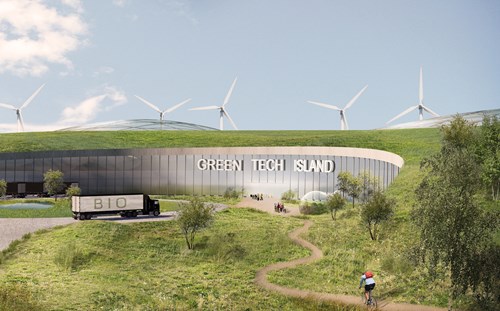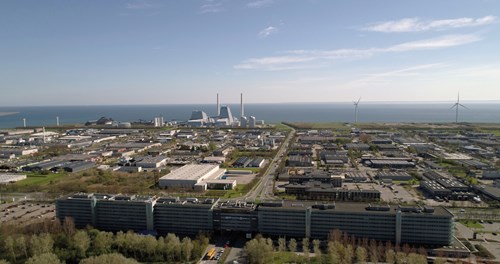
Holmene (Danish for “The Islets”) will consist of nine islets, forming an expansive business district in extension of Avedøre Holme.
Holmene will lie adjacent to the current Avedøre Holme and serve as a business district for the future.
The plan underlying Holmene, located in Hvidovre Municipality, is to establish one of Northern Europe’s largest, greenest and most innovative business districts in extension of Avedøre Holme.
By restoring the original landscape and connecting the new district’s nine islets with a “green belt” of natural surroundings, Holmene will provide 700,000 square metres of new, natural scenery in an urban location, along with 17 kilometres of new coastline.
Until the 1960s, the area now known as Avedøre Holme was dotted with small islands, ponds and lush nature that was allowed to grow wild. In the 1960s, the area was drained, filled and transformed into one of the Nordic region’s largest and best-functioning business districts. Given the continued high demand for an address at Avedøre Holme, the area is now ripe for expansion.
Upon completion in 2045, Holmene will consist of nine islets. These islets will be constructed in stages. The first islet will be completed six years after the work commences.
Holmene will give Greater Copenhagen and Denmark a new, ultramodern business district measuring 3.2 million square metres, featuring new and innovative traffic solutions and providing room for around 380 new businesses. The islets will offer businesses the opportunity to gather in clear geographical clusters, unleashing circular synergies and enabling knowledge sharing and joint branding activities.
With its proximity to public transport, an international airport and large educational institutions, Holmene will strengthen the position of Greater Copenhagen in the battle to attract businesses, international investment and highly qualified labour, while also future-proofing continued business growth in the capital region.
Get a short introduction to Holmene here (link to video on YouTube)
One of the nine islets could be green. At Green Tech Island, wastewater from the residents and businesses of Greater Copenhagen will be transformed into clean water.
Green Tech Island is one of the nine planned islets. It will help to make Denmark’s capital one of the world’s greenest. It is a place where the things we dispose of can be used to produce green energy and resources that we need. A place where wastewater from the residents and businesses of Greater Copenhagen will be transformed into clean water. Where sludge and bio-waste can be converted into sustainable biogas. Where we can store surplus green energy from wind turbines, for use on wind-free days. And a place where new technologies can be tested, catapulting Denmark to the forefront of the world elite in smart energy utilisation and production.

Holmene will not only be a business district. The residents of Hvidovre and Greater Copenhagen as a whole will also benefit from the future district. Holmene will provide 700,000 square metres of new nature areas in an urban location. Some areas may become recreational landscapes, while a number of the small islets can be designed as untouched nature reserves that are not accessible to people. This translates to new opportunities for plant and animal life.
The establishment of a landscape of islets can create an active coastline with jogging routes, cycle paths, water sports and scenic marine spots, offering a wealth of activities for associations and sporting enthusiasts.
Educational nature sites along the coast can attract families and school classes, who can engage with nature and learn about animal and plant life. The landscape will also be an asset in people’s working lives – among other things, it will be more attractive to cycle to work.
Here you can see a selected overview of activities that Holmene will offer.

Holmene will be established in extension of Avedøre Holme. Until 1964, the area was home to small islets, ponds and lush nature, forming the coastline in the area that is now known as the Avedøre Holme industrial district.
Nature was allowed to grow wild here. Sandklappen, Smaaholme and Storeholm were part of the uninhabited landscape, where cows grazed in the summer, and which was also a popular hunting area with a rich diversity of plants and animals.
In the post-war period, factories moved out of the city, fuelling demand for large new industrial sites in Greater Copenhagen.
In the 1960s, an extensive land expansion project was launched, with a dam built to drain a large section of the shallow waters around the islets. Nature was replaced by industry, later joined by important utility plants for electricity, district heating and wastewater.
Today, Avedøre Holme is home to around 400 businesses with a total of 12,000 employees. The area is now fully developed, and there is demand for more space for new businesses. Therefore, Holmene will be a welcome extension of Avedøre Holme. The combination of the existing Avedøre Holme and the new business district Holmene will further boost the development of business in Greater Copenhagen.

The vision of Holmene was developed by Hvidovre Municipality. The idea was born three years ago, after which we conducted a series of studies looking at the geological conditions, nature and environment, sea currents, and traffic. We have also been in ongoing dialogue with neighbouring municipalities, business organisations, agencies, associations, universities, investors and stakeholders.
What is the role of the Danish Government in the project?
The Government has decided to support the vision, and Holmene will now be incorporated into the Government’s overall plan for Greater Copenhagen. The state is an important player in terms of developing the framework for business in Greater Copenhagen and meeting the challenges relating to traffic.
The main driver is the high demand for commercial plots at Avedøre Holme. Land is being sought by modern logistics companies, high tech manufacturers, warehouses, etc. Hvidovre Municipality is fully developed and does not have vacant space for these types of businesses elsewhere.
Construction of the islands will cost 2.3 billion DKK. This cost will be covered by the money we receive for accepting the earth that will be used in the construction. Additional costs of establishing fibre-optic networks, bridges, roads and sewers will amount to 475 million DKK. Meanwhile, the municipality will receive income of approximately 1.4 billion DKK in connection with the sale of the commercial plots.
The islets of Holmene will be built one by one so that the first businesses can move in as soon as the first islet is completed.
Holmene will not cost taxpayers in Hvidovre one cent – the project is designed to fund itself, which means that it will not negatively impact the municipality's finances at all. In fact, the overall balance sheet for the project shows that the construction of Holmene will generate income of approximately 1 billion DKK from the sale of commercial plots at Holmene. Hvidovre Municipality’s share of these profits will correspond to its share of ownership in the future consortium.
The earth will come from construction projects in Greater Copenhagen. COWI estimates that there is enough earth for Holmene in Hvidovre and Lynetteholmen deriving from projects planned in Greater Copenhagen over the next 30 years. Furthermore, earth is available from projects throughout Denmark and surplus earth can also be imported from Sweden. These last two options serve as a backup plan if, contrary to expectations, sufficient earth cannot be sourced within Greater Copenhagen.
Holmene will be green in many ways. One of the islets – Green Tech Island – will house one of the world’s most modern plants, with operations that include the transformation of wastewater into green energy. There will also be a general focus on attracting businesses that use green technology and are committed to sustainability and innovation.
Holmene will also be green in a very literal sense. The nine islets will be rich in plant vegetation, adding 17 km of new coastline and 700,000 square metres of new nature. With Holmene, we will create nature areas and biodiversity of a scope and quality that – at a very minimum – offsets any natural areas impacted by the construction of the islets. That is what makes Holmene a “nature plus” project.
Lastly, Holmene will be green in the sense that it will offer a range of new recreational activities for citizens: a bird tower, cycle paths, kayaking, surfing, snorkelling, etc.
There are already challenges in terms of congestion on and around Amager Motorway and Avedøre Holme, and it is clear that up to 12,000 new jobs at Holmene will only add to these challenges. Therefore, we are focused on improving the traffic conditions for public transport, motorists and cyclists. The Government also has a focus on traffic in the area. For example, the Finance Act for 2019 allocates funding for a preliminary study on expanding the capacity of Amager Motorway.
We expect that the traffic problems will be solved by the time we open the first islet.
We recently approved the upgrade of bus line 500S from Glostrup Station to Avedøre Holme, effective 2024, and we are also working for the future establishment of light rail service to Avedøre Holme.
We will minimise noise as much as possible – both during construction and after Holmene is completed. During the construction of Holmene, we plan to implement mandatory routes for lorries transporting earth so as to minimise inconveniences for citizens.
Holmene is a long-term project. It will be possible to utilise new technologies to reduce noise impacts for citizens and to ensure that businesses in the district comply with the applicable policies and regulations in an area with green values and housing.

The nine islets will also have a flood protection function. The 5.5-metre-high dikes around the islets will be able to withstand heavy storms and high waters.
Hvidovre Municipality’s vision is that Holmene will be home to various types of businesses – both in terms of size and industry. But they will all share a green and sustainable profile. We also work to promote business symbiosis, where businesses in related industries are work side by side to foster innovation and product development collaborations.
Pressrelease: The Government and Hvidovre Municipality unveil plans for one of Northern Europe’s largest, greenest and most innovative business districts (pdf)
Fact sheet: Holmene - green business park of the future (pdf)
Find illustrations of Holmene here
Anders Wolf Andresen, mayor of Hvidovre Municipality, via press manager Hanne Rasmussen, tlf. 51 58 78 14
Gert S. Nelth, director of the central administration, Hvidovre Municipality. Tlf. 51 58 78 07 eller gsn@hvidovre.dk